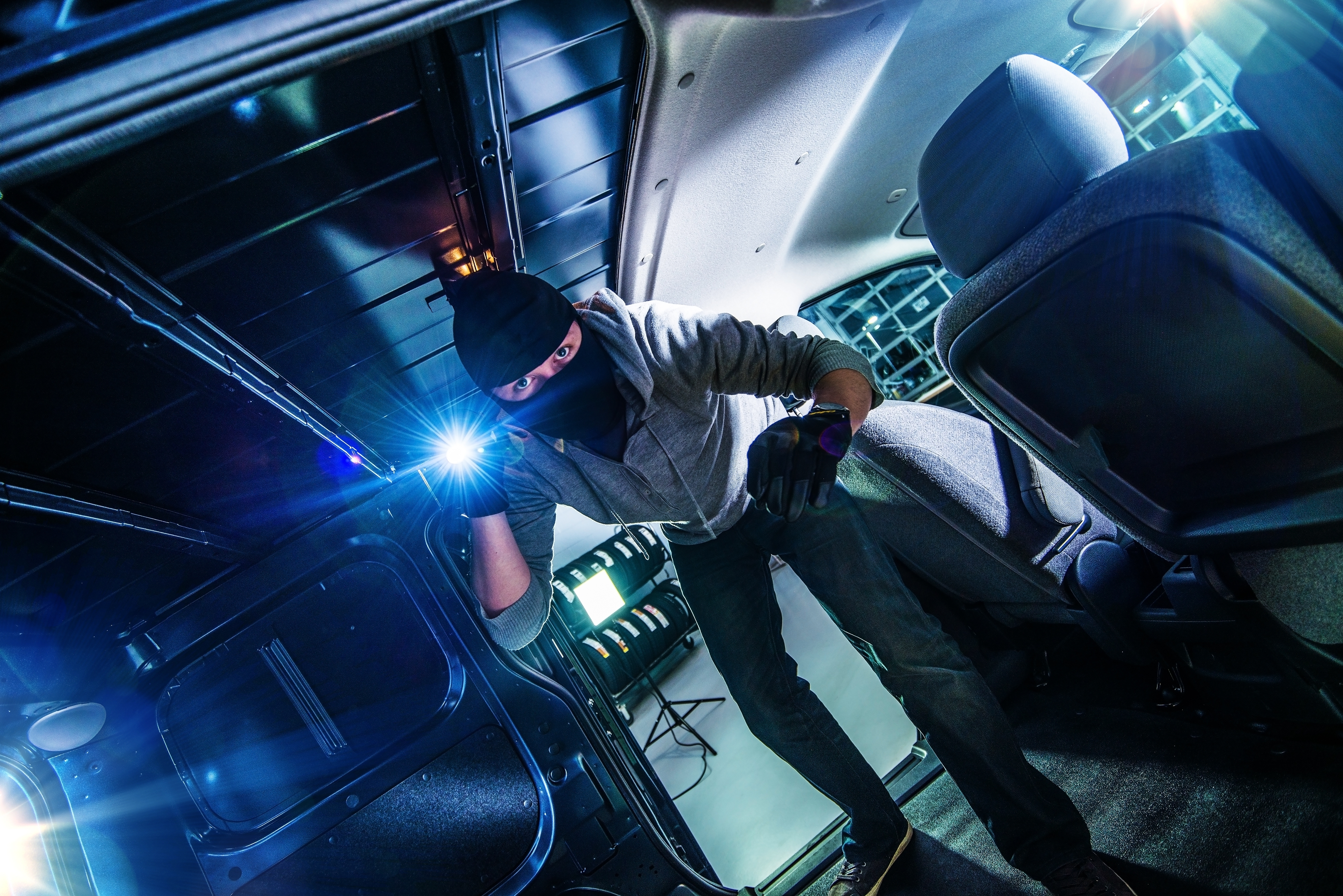
Miranda Blake
Tipy na zabezpečenie vozidla: Ochrana vášho nákladného vozidla pred krádežou
Vytvorené: 14. 11. 2024
•
Aktualizované: 14. 11. 2024
Dopravné spoločnosti v Spojenom kráľovstve a Európe môžu výrazne znížiť riziko krádeže vozidiel a nákladu. Ochrana nákladného vozidla nie je len o zabezpečení samotného vozidla; zahŕňa komplexný prístup, ktorý zahŕňa technológie, školenia, zapojenie komunity a proaktívne plánovanie. So správnymi opatreniami môžu manažéri vozových parkov zaistiť bezpečnosť vodičov a integritu majetku, čím podporia bezpečné prostredie pre svoje prevádzky.
Čo by mali vodiči robiť
Zabezpečenie vozidla
Zvýšte bezpečnosť svojho vozidla použitím rôznych zariadení, ako sú visiace zámky, jedinečne očíslované plomby a sklopné šnúry. Tie by sa mali použiť ihneď po naložení, aby sa vytvorila ďalšia vrstva ochrany pred neoprávneným prístupom.
Dôkladné kontroly sú nevyhnutné. Po každej zastávke venujte chvíľu kontrole nákladného vozidla a jeho nákladu. Hľadajte akékoľvek známky manipulácie alebo podozrivej činnosti. Ostražitosť je rozhodujúca pri predchádzaní prípadom krádeže.
Dokumentácia
Udržujte komplexný kontrolný zoznam zabezpečenia vozidla. Mal by byť ľahko dostupný na nahliadnutie príslušníkom pohraničnej stráže alebo iným orgánom, ak sa to vyžaduje. Nielenže tým preukážete svoje odhodlanie, ale zároveň to pomôže pri vyšetrovaní v prípade krádeže.
Bezpečné miesta
Vyberajte si dobre osvetlené a frekventované parkovacie miesta. Oblasti s veľkým pohybom chodcov a monitorovacími kamerami sú pre zlodejov menej atraktívne. Ak je to možné, využívajte určené bezpečné parkoviská, ktoré sú vybavené obvodovým oplotením a modernými monitorovacími systémami alebo bezpečnostnými pracovníkmi. Tieto miesta poskytujú dodatočnú úroveň bezpečnosti. Na nočné parkovanie si vyberajte miesta, ktoré sú osvetlené a monitorované.
Nájdite bezpečné parkovisko pre nákladné vozidlá na svojej tranzitnej trase pomocou mapy SNAP.

Technológia a vybavenie
Zapojenie modernej technológie môže výrazne posilniť bezpečnosť vášho vozidla. Vybavte svoje nákladné vozidlo modernými systémami vrátane sledovania GPS, imobilizérov a panikových alarmov. Tie nielenže zabránia krádeži, ale pomôžu aj pri odstraňovaní následkov nehody.
Plánovanie trasy
Okrem toho vám efektívne plánovanie ciest pomôže vyhnúť sa rizikovým oblastiam. Využívajte softvér, ktorý vám umožňuje mapovať trasy doručovania a vyhýbať sa známym miestam krádeží nákladu. Zavedením telematiky a technológie GPS na monitorovanie vozidla v reálnom čase - budete môcť sledovať jeho polohu a zabezpečiť dodržiavanie plánovaných jázd.
Čo by mali prevádzkovatelia vozového parku urobiť
Bezpečnostné protokoly a systémy
Dobre definovaný súbor bezpečnostných protokolov je nevyhnutný pre všetkých vodičov. Ako prevádzkovateľ vozového parku im môžete poskytnúť komplexné písomné usmernenia s podrobným opisom bezpečnostných opatrení, ktoré by mali dodržiavať. Takýto prístup zabezpečí, že všetci budú na rovnakej strane, pokiaľ ide o bezpečnostné postupy.
Vodičov by ste mali zaškoliť, ako efektívne používať systémy nainštalované v nákladných vozidlách. Oboznámenie sa s týmito zariadeniami môže zvýšiť ich účinnosť. Je tiež dobré poučiť ich o potenciálnych hrozbách a dôležitosti ostražitosti. Mali by poznať bežné taktiky, ktoré používajú zlodeji, a vedieť, ako na ne primerane reagovať.
Udržiavanie nákladných vozidiel v optimálnom stave znižuje riziko porúch, ktoré by mohli viesť ku krádeži. Zavedením proaktívneho plánu údržby zabezpečíte, aby boli vaše vozidlá vždy v dobrom technickom stave. Pravidelné kontroly môžu zabrániť mechanickým poruchám, ktoré by mohli spôsobiť zraniteľnosť vašich nákladných vozidiel.
Komunikácia a komunita
Vytvorenie jasných komunikačných kanálov je nevyhnutné pre efektívne riadenie bezpečnosti. Udržujte otvorenú komunikáciu medzi vodičmi, dispečermi a bezpečnostným personálom. To umožňuje okamžité nahlásenie akejkoľvek podozrivej činnosti alebo problémov s vozidlom. Povzbudzujte vodičov, aby sa pravidelne hlásili počas svojej zmeny.
Zapojenie miestnej komunity môže posilniť vaše bezpečnostné opatrenia. Spolupracujte s inými podnikmi a miestnymi orgánmi činnými v trestnom konaní a zdieľajte informácie o potenciálnych hrozbách. Spoločný prístup môže zvýšiť informovanosť a viesť k účinnejším stratégiám prevencie kriminality. Zapojte sa do komunitných iniciatív, ktoré sa na to zameriavajú - budovanie vzťahov môže vytvoriť podpornú sieť, ktorá pomôže pri ochrane vášho majetku.
Plány reakcie
Pevný plán pre prípad núdze môže zmierniť následky krádeže. Vypracujte jasné protokoly pre reakciu na incidenty. Mal by obsahovať kroky na nahlásenie, kontaktovanie orgánov činných v trestnom konaní a oznámenie poskytovateľovi poistenia. Zabezpečte, aby s nimi boli oboznámení všetci vodiči - mali by vedieť, ako rýchlo a účinne konať.
Situačné povedomie
Školenie vodičov, aby si všímali svoje okolie, môže zabrániť krádežiam. Poučte ich o tom, ako rozpoznať podozrivé aktivity v okolí svojich vozidiel, a nabádajte ich, aby dôverovali svojim inštinktom a nahlásili akékoľvek nezvyčajné udalosti. Okrem toho zdôraznite, že je dôležité uprednostniť osobnú bezpečnosť pred nákladom. V prípade konfrontácie so zlodejom by mali poslúchnuť a nahlásiť incident úradom hneď, ako to bude bezpečné.
Monitorovanie transakcií s palivom pomocou SNAP
Poskytujeme inteligentný platobný systém, ktorý automaticky zaznamenáva a sleduje transakcie s palivom. Keď vodiči tankujú svoje vozidlá na ktoromkoľvek z viac ako 3 500 miest v Spojenom kráľovstve, jednoducho predložia svoju palivovú kartu SNAP na zaplatenie transakcie, čím sa eliminuje potreba hotovosti alebo kreditných kariet, čo zjednodušuje proces.
Systém automaticky pripíše každú transakciu s palivom na účet priradený k evidenčnému číslu vozidla. Takáto automatizácia odstraňuje potrebu vodičov ručne zbierať a predkladať účtenky, čím sa znižuje administratívna záťaž a možnosť vzniku chýb.
Manažéri vozového parku dostávajú mesačné faktúry s podrobným prehľadom o činnosti všetkých svojich vozidiel, čo umožňuje jednoduché monitorovanie spotreby paliva a výdavkov v rámci celého vozového parku.
Služba SNAP Fuel je integrovaná s ostatnými službami účtu SNAP, čo umožňuje manažérom vozového parku sledovať nielen transakcie s palivom, ale aj služby parkovania a umývania v rámci jedného účtu, čím sa získa komplexný prehľad o prevádzke a výdavkoch. Viac informácií o službe SNAP Fuel nájdete tu.



